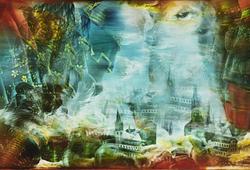An antique Agra carpet Of Mughal 'Shrub' design, Northern India, c. 335 x 287 cm.
Around 1890. An ivory ground with a large polychrome trellis with flowers, so-called "Shrub" design. Wine red main border with palmette and floral vine.
Muut tiedot
During the 17th century, particularly when Emperor Shah Jahan ruled (1628–1658), the Mughals in India began to place great importance on depicting flowers in a naturalistic manner in their textiles and carpets. On beautiful ruby-red backgrounds, rows of flowers such as lilies, poppies, carnations, tulips, violets, and daffodils were woven—often so detailed that one could recognise the species.
These flower-inspired patterns remained popular for several hundred years. Over time, however, weavers began to take greater artistic liberties, making the flowers less realistic and sometimes difficult to identify.
The carpet described here features a pattern reminiscent of the early Mughal carpets, but instead of a red background, it has a light, ivory-coloured ground. The flowers are smaller and not as easily identifiable.
In the 19th century, it became common to weave similar carpets in the prisons of Agra and Lahore. Many carpets with similar floral patterns were created there, often with slightly altered colours and details.













































